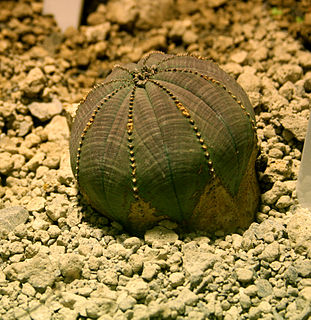
Euphorbia obesa is a subtropical succulent species of flowering plant in the genus Euphorbia. It comes from South Africa, especially the Cape Province. Sometimes referred to as the baseball plant.

Agrotis obesa is a moth of the family Noctuidae. It is found from south-eastern Europe, the Near East and the Middle East to China. In North Africa, it is known from Morocco to Algeria.
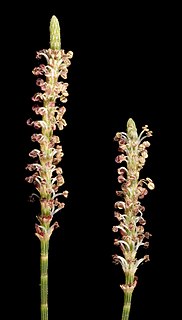
Casuarina obesa, commonly known as swamp she-oak or swamp oak, is a species of Casuarina that is closely related to C. glauca and C. cristata. The Noongar peoples know the plant as Goolee, Kweela, Kwerl and Quilinock.
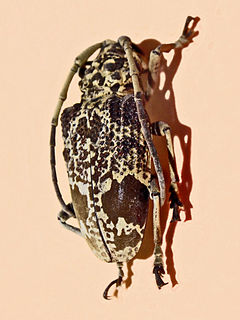
Phryneta is a genus of flat-faced longhorn beetles belonging to the family Cerambycidae.

Phrynetini is a tribe of longhorn beetles of the subfamily Lamiinae. It was described by Thomson in 1864.
Phryneta flavescens is a species of beetle in the family Cerambycidae. It was described by Stephan von Breuning in 1954. It is known from Tanzania.
Phryneta hecphora is a species of beetle in the family Cerambycidae. It was described by James Thomson in 1857. It is known from Mozambique and Democratic Republic of the Congo.

The Castilloa Borer is a species of beetle in the family Cerambycidae. It was described by Johan Christian Fabricius in 1775, originally under the genus Lamia. It has a wide distribution throughout Africa. It feeds on Morus alba, Hevea brasiliensis, Coffea arabica, and Chlorophora excelsa.
Phryneta luctuosa is a species of beetle in the family Cerambycidae, also called lamiines or flat-faced longhorned beetles. It was described by Murray in 1870. It is known from Cameroon and Nigeria.

Phryneta aurocincta is a species of beetle in the family Cerambycidae. It was described by Félix Édouard Guérin-Méneville in 1832, originally under the genus Lamia. It has a wide distribution throughout Africa.
Phryneta conradti is a species of beetle in the family Cerambycidae. It was described by Hermann Julius Kolbe in 1894. It is known from the Democratic Republic of the Congo, Tanzania and Malawi.
Phryneta crassa is a species of beetle in the family Cerambycidae. It was described by Karl Jordan in 1903. It is known from the Central African Republic, Gabon, and the Democratic Republic of the Congo.
Phryneta ellioti is a species of beetle in the family Cerambycidae. It was described by Charles Joseph Gahan in 1909. It is known from Uganda and the Democratic Republic of the Congo.
Phryneta ephippiata is a species of beetle in the family Cerambycidae. It was described by Francis Polkinghorne Pascoe in 1864. It is known from South Africa and Namibia.
Phryneta escalerai is a species of beetle in the family Cerambycidae. It was described by Báguena and Stephan von Breuning in 1958. It is known from Bioko.
Phryneta obliquata is a species of beetle in the family Cerambycidae. It was described by Harold in 1878. It is known from Tanzania, Uganda, Somalia, the Democratic Republic of the Congo, Ethiopia and Kenya.
Phryneta pallida is a species of beetle in the family Cerambycidae. It was described by James Thomson in 1857. It is known from South Africa.
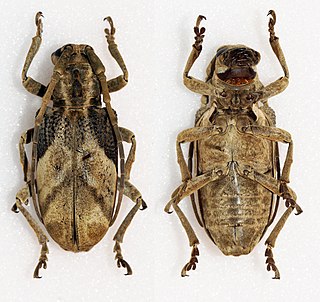
Phryneta semirasa is a species of beetle in the family Cerambycidae. It was described by Dohrn in 1885. It is known from Tanzania, the Democratic Republic of the Congo, Mozambique, Zimbabwe, Malawi, and Zambia.
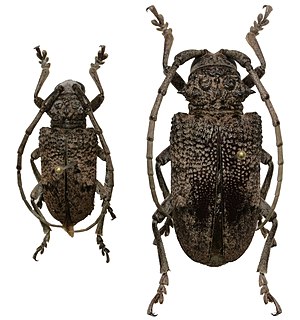
The Fig-tree Borer Longhorn Beetle, or Fig Tree Borer, is a species of beetle in the family Cerambycidae. It was described by Johan Christian Fabricius in 1792, originally under the genus Lamia. It has a wide distribution throughout Africa. It feeds on Pyrus communis, Ficus carica, Salix babylonica, Cupressus sempervirens, and Vitis vinifera.

Phryneta verrucosa is a species of beetle in the family Cerambycidae. It was described by Dru Drury in 1773, originally under the genus Cerambyx. It is known from Equatorial Guinea, and was introduced into Barbados, Grenada, and Trinidad and Tobago.









